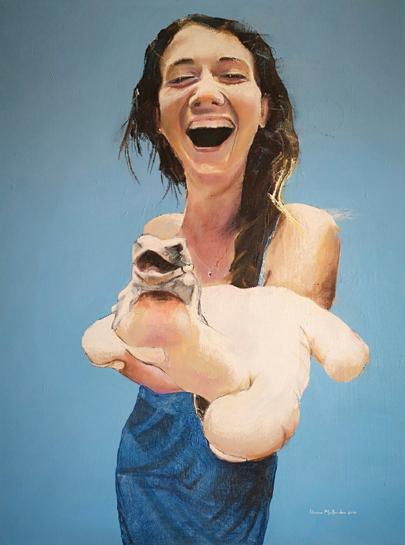
2 minute read
art-ist
Linus Malherbe - The inspired artist
An elfin face under a Middle Eastern head scarf, an ekipa hanging around the neck, a slash of thick white paint cutting across the canvas. A woman stands defiant in a flowing scarlet dress with her sword sheathed at her side. Next to her is a large endangered white rhino. Both stare at the viewer indifferently, perhaps defiantly. These are two paintings of Linus Malherbe, a self-taught Namibian artist whose striking modern depictions of wildlife combined with futuristic figures have quickly become well-known in his home town of Windhoek. His paintings juxtapose the past with the present, modernity with antiquity, fantasy and fact. Oppression, prejudice and attempting to right past wrongs are a major theme of Linus’ work, which often depicts women or endangered and vulnerable species. His inspiration is Namibia - its honesty and openness. Yet it is the mystery of the White Lady rock painting that he is particularly intrigued with, resulting in images of what his Dame Blanche might have looked like. He has learnt everything he could about where she could have been from, her possible Vikingrelated culture and history, and imagined what it must have been like for this foreigner to be encamped in the rocky desert around the Brandberg, a world away from home.

Linus’ own past has informed much of where his obsession with putting past wrongs right comes from. He was a child when Apartheid was in its last stages of atrophy. And while his artistic talent was clear from as early as the age of ten, but as he grew older, being “artistic” was not the feat it is today. The Afrikaner culture at the time informed the perception of masculinity as rough and tough, as what we would today refer to as “toxic masculinity”. Thus Linus stepped away from his passion, choosing the next best thing which was architecture. Only later, much older and perhaps a little braver in the face of society’s judgements, did he decide to give art a serious try.

Since he had never gone to art school, Linus developed a distinct and unique technique of his own. After living in America for fifteen years he moved his family back to Namibia and expected his transition into art to be slow. But to his surprise it took off quickly and now serves as a major source of income during a time when architects are not as much in demand. It seems that art will always be.

The commissioned portrait of President Geingob presented to him by Linus.
Art needs to be debated, to be dissected and discussed. But no matter what the subject is, one thing is certain: when the artist is long gone, their artwork will be there to entice us with its mystery, to delight us and inspire us. Linus’ artwork may have ruffled many feathers, but it also starts conversations about who we are and where we come from. And that, after all, is the point.
Nina van Zyl









